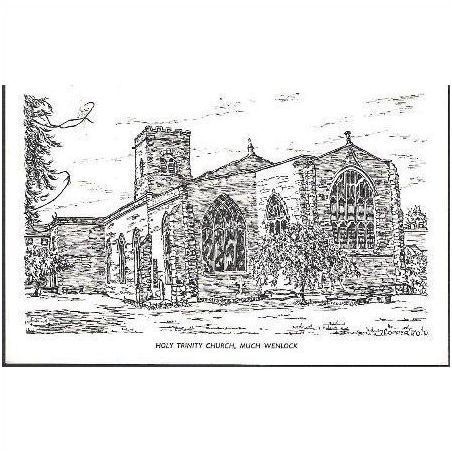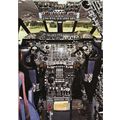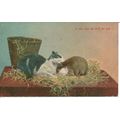Much Wenlock, Shropshire - Holy Trinity Church - art postcard 1972
- Condition : Used
- Dispatch : 2 Days
- Brand : None
- ID# : 110261361
- Quantity : 1 item
- Views : 8819
- Location : United Kingdom

- Seller : justthebook (+1699)
- Barcode : None
- Start : Thu 20 Jun 2013 19:23:23 (EDT)
- Close : Run Until Sold
- Remain : Run Until Sold
Checks/Cheques
 for 1 item(s) edit
for 1 item(s) edit
Shipping Calculator
More Listings from This Seller view all
Seller's Description
- Postcard
- Picture / Image: Holy Trinity, Much Wenlock, Shropshire - artist postcard
- Publisher: Copper Hill (drawing)
- Postally used: yes
- Stamp: 3p ultramarine Machin
- Postmark(s): not legible but looks like 1972 in cds
- Sent to: Cheam, Surrey
- Notes / condition:
Please ask if you need any other information and I will do the best I can to answer.
------------------------------------------------
Postage & Packing:
UK (incl. IOM, CI & BFPO): 99p
Europe: £1.60
Rest of world (inc. USA etc): £2.75
No additional charges for more than one postcard. You can buy as many postcards from me as you like and you will just pay the fee above once. (If buying postcards with other things such as books, please contact or wait for invoice before paying).
Payment Methods:
UK - PayPal, Cheque (from UK bank) or postal order
Outside UK: PayPal ONLY (unless otherwise stated) please. NO non-UK currency checks or money orders (sorry).
NOTE: All postcards are sent in brand new stiffened envelopes which I have bought for the task. These are specially made to protect postcards and you may be able to re-use them. In addition there are other costs to sending so the above charge is not just for the stamp!
I will give a full refund if you are not fully satisfied with the postcard.
----------------------------------------------
Text from the free encyclopedia WIKIPEDIA may appear below to give a little background information (internal links may not work) :
*************
Much Wenlock, earlier known as Wenlock, is a small town in central Shropshire, England. It is situated on the A458 road between Shrewsbury and Bridgnorth. Nearby, to the northeast, is the Ironbridge Gorge, and the new town of Telford. The Wenlock Olympian Games set up by Dr William Penny Brookes in 1850 are centred in the town and in venues across Shropshire. Dr Brookes is credited as a founding father of the Modern Olympic Games, and the Olympic mascot for London 2012 is named Wenlock after the town.
The ""Much"" was added to the name to distinguish it from the nearby Little Wenlock, and signifies that it is the larger of the two settlements. Notable historic attractions in the town are Wenlock Priory and the Guildhall. The name ""Wenlock"" is known as an old wooden ship found in Much Wenlock and Little Wenlock (and also Great Wenlock, a now obsolete name, but found in some historic sources[1]) is probably derived from the Old English *Wenan loca meaning ""Wena's Stronghold"" (wéna being feminine and meaning ""hope"").[2] The town was recorded in the Domesday Book as Wenloch.[2] The population of the town's parish, according to the 2001 census, was 2,605.
The town grew around an abbey or monastery founded around 680[3] by Merewalh, a son of King Penda of Mercia. King Penda installed his daughter Milburga as abbess in 687. Milburga of Wenlock was credited with many miraculous works.[4] The abbey flourished until around 874 when a Danish Viking attack occurred. In the 11th century another religious house was built on the same site by Leofric, Earl of Mercia and Countess Godiva his wife. In the 12th century this was replaced by a Cluniac priory, established by Roger de Montgomerie after the Norman Conquest, the ruins of which can still be seen and which is now in the hands of English Heritage. It prospered until the Dissolution of the Monasteries in 1539.
Other architectural attractions include the 16th century Guildhall, many other historic buildings in the Early English style and an annual well dressing at St Milburga's Well on Barrow Street. The town was incorporated under the name of ""Bailiff, Burgesses and Commonalty"" by Edward IV in 1468 at the request of Sir John Wenlock, and ""in consideration of the laudable services which the men of the town performed in assisting the king to gain possession of the crown,"" and the charter was confirmed in 1547 by Henry VIII and in 1631 by Charles I.[5]
The town is known as the birthplace of Wenlock Olympian Games set up by Dr William Penny Brookes and his Wenlock Olympian Society (WOS) in 1850. In 1861 he was also instrumental in setting up the Shropshire Games and later in 1866, the National Olympian Games. Dr Brookes is credited as a founding father of the Modern Olympic Games. In 1890 it was the turn of the Raven Hotel to be the venue for the annual post Wenlock Olympian Games' dinner, and Baron Pierre de Coubertin was the guest of honour. Copies of some of the WOS's archive images are on display in the hotel, including letters from Coubertin to Brookes. The Wenlock Olympian Games, a nine-day event staged on eight sites across Shropshire, are still held annually during July, and are still organised by WOS. The town's secondary school is named after Dr Brookes.
The Olympic mascot for London 2012 was named Wenlock [6] to honour Dr Brookes, WOS and Much Wenlock. On 30 May 2012, the Olympic flame of the London 2012 Summer Games, was carried through Much Wenlock to acknowledge the founding footsteps of Dr Brookes.[7]. WOS Vice President, John Simpson, carried an Olympic torch from the town into the William Brookes School.
A borough of Wenlock existed until 1966 which, at its height, was the largest borough in England[citation needed] outside London and encompassed several of the towns that now constitute Telford. The borough had unusual boundaries, covering Much Wenlock itself, but also Little Wenlock, Broseley and Ironbridge. 1966 saw the core Wenlock parts become part of the Bridgnorth Rural District, with other parts also going to Dawley Urban District and to Wellington Rural District.
On 7 April 2011 Much Wenlock was announced by Decentralisation Minister Greg Clark as one of the first seventeen communities to test neighbourhood planning, a key feature of the Localism Bill. The Much Wenlock Neighbourhood Plan was launched on 22 November 2011.
Much Wenlock was the location for the third episode of the first series of the archaeology television programme Time Team in 1994.[8]
Holy Trinity Church, in Wilmore Street, is the Church of England parish church. The first church on this site was built in Anglo-Saxon times. The present church dates from 1150 and was built by the Cluniac monks from Wenlock Priory. Features of interest include the plain Norman tower which had a spire until early in the twentieth century, and a memorial inside the church to W. P. Brookes as well as the refurbished family gravestones in the churchyard. The churchyard is a large, open, green space with some tall trees. The Shit Brook ran along the road towards the church before it was culverted. There is also a Methodist church in King Street. The town's former Roman Catholic Church of St Mary Magdalene, in Barrow Street, closed in 2008. The church of St Mary Magdalene was demolished in 2012 and domestic properties built in its place.
type=printed postcards
theme=topographical: british
sub-theme=england
county/ country=shropshire
number of items=single
period=1945 - present
postage condition=posted
Listing Information
| Listing Type | Gallery Listing |
| Listing ID# | 110261361 |
| Start Time | Thu 20 Jun 2013 19:23:23 (EDT) |
| Close Time | Run Until Sold |
| Starting Bid | Fixed Price (no bidding) |
| Item Condition | Used |
| Bids | 0 |
| Views | 8819 |
| Dispatch Time | 2 Days |
| Quantity | 1 |
| Location | United Kingdom |
| Auto Extend | No |



















